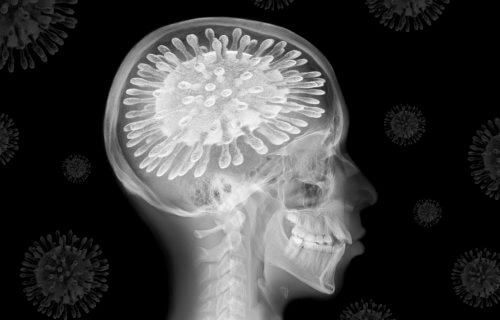STANFORD, Calif. — Around one in three people who contract COVID-19 go on to suffer some form of brain damage due to their illness. Now, a new study may have the answer to why this is happening. Researchers at Stanford Medicine say they have discovered “unmistakable signs” of inflammation and damaged brain circuits among patients who have died during the pandemic. What’s even more troubling is this inflammation appears to be very similar to what doctors see in patients who have Alzheimer’s disease and other neurodegenerative diseases.
Investigators from the Stanford School of Medicine and Saarland University in Germany add these findings likely explain why so many COVID patients experience issues like brain fog and mood problems during and after their infections. Stanford’s Dr. Tony Wyss-Coray notes one-third of hospitalized coronavirus patients report symptoms including fuzzy thinking, forgetfulness, difficulty concentrating, and depression. These problems are also typical in COVID “long-haulers,” who continue to have side-effects weeks and months after recovering from the virus.
Despite all of this brain-related trauma, researchers couldn’t find any signs of the SARS-CoV-2 virus in the brain tissue of eight deceased COVID patients. However, while comparing those samples to the brains of 14 other people who died from non-COVID causes, study authors spotted a key clue.
“The brains of patients who died from severe COVID-19 showed profound molecular markers of inflammation, even though those patients didn’t have any reported clinical signs of neurological impairment,” says Wyss-Coray, a professor of neurology and neurological sciences, in a university release.
Currently, scientists continue to disagree about whether COVID-19 reaches a patient’s brain or not.
“We used the same tools they’ve used — as well as other, more definitive ones — and really looked hard for the virus’s presence,” Wyss-Coray adds. “And we couldn’t find it.”
Is COVID sending signals through the blood-brain barrier?
Study authors say what makes COVID’s impact on the brain so puzzling is the virus’s apparent ability to defeat the blood-brain barrier. This blob-like structure which protects the brain is usually very selective about what cells and substances can pass through it.
However, Wyss-Coray’s team and other scientists have proven that bloodborne factors outside the brain can still send signals through the barrier. Those signals can trigger inflammation responses in the brain without actual exposure to harmful particles.
As an example, Wyss-Coray’s group showed that genetic factors in young mice’s blood can rejuvenate the cognitive abilities in older mice. Conversely, blood from older mice can also damage the thinking power of younger mice.
After seeing the conflicting reports about COVID-19’s ability to enter the brain, Stanford researchers started looking at the neurological symptoms of COVID more closely. Unfortunately, getting a hold of brain samples from coronavirus victims is difficult due to the risk of exposure to the virus. Thankfully, study co-author Dr. Andreas Keller was able to access brain tissue samples from autopsies conducted by Saarland University.
What’s happening in the brain during a COVID infection?
Using single-cell RNA sequencing, scientists studied the activation of thousands of genes in each of the 65,309 brain cells of the COVID and non-COVID tissue samples. Those findings reveal significant differences in the brains of people dying of COVID-19 compared to those dying of other causes.
Many of the switched-on genes in the COVID victims’ brains had a connection to triggering inflammation. These brains also showed signs of distress in the neurons inside the cerebral cortex, the region which controls decision-making, memory, and reasoning. These neurons also form a complex series of logic circuits within the mind which handle higher brain functions.
Study authors also discovered molecular changes in the outer layers of the cerebral cortex of patients with COVID-19. The team suggests this may have suppressed the normal signaling of neurons in the brain, like hitting the brakes in a car. This kind of imbalance in brain signaling also happens to have a connection to mental decline in diseases like Alzheimer’s and Parkinson’s disease.
Moreover, researchers found brains affected by COVID-19 contained more T cells. These immune cells patrol the body for pathogens and appear in far fewer numbers in healthy brains.
“Viral infection appears to trigger inflammatory responses throughout the body that may cause inflammatory signaling across the blood-brain barrier, which in turn could trip off neuroinflammation in the brain,” Wyss-Coray reports.
“It’s likely that many COVID-19 patients, especially those reporting or exhibiting neurological problems or those who are hospitalized, have these neuroinflammatory markers we saw in the people we looked at who had died from the disease,” the researcher concludes. “Our findings may help explain the brain fog, fatigue, and other neurological and psychiatric symptoms of long COVID.”
The study appears in the journal Nature.
